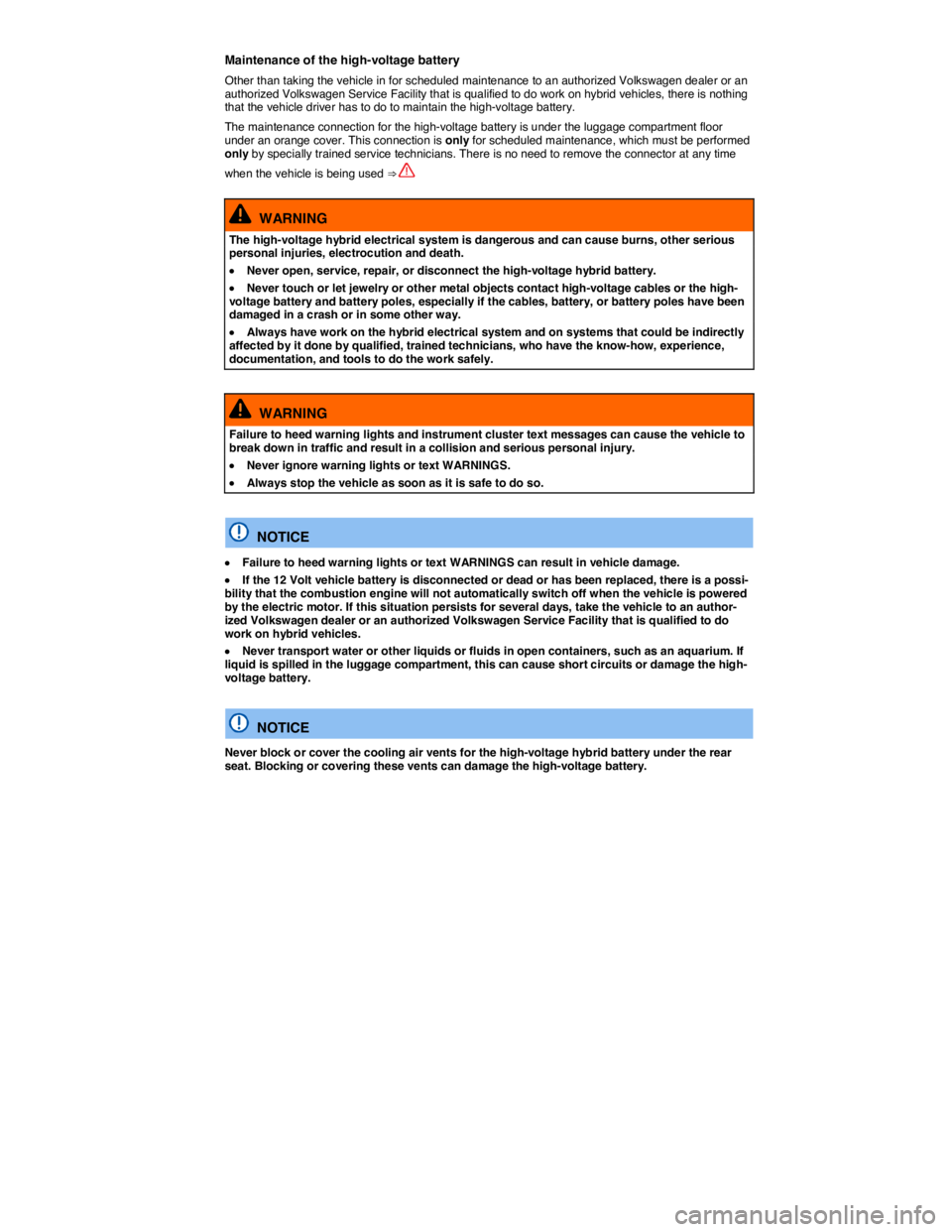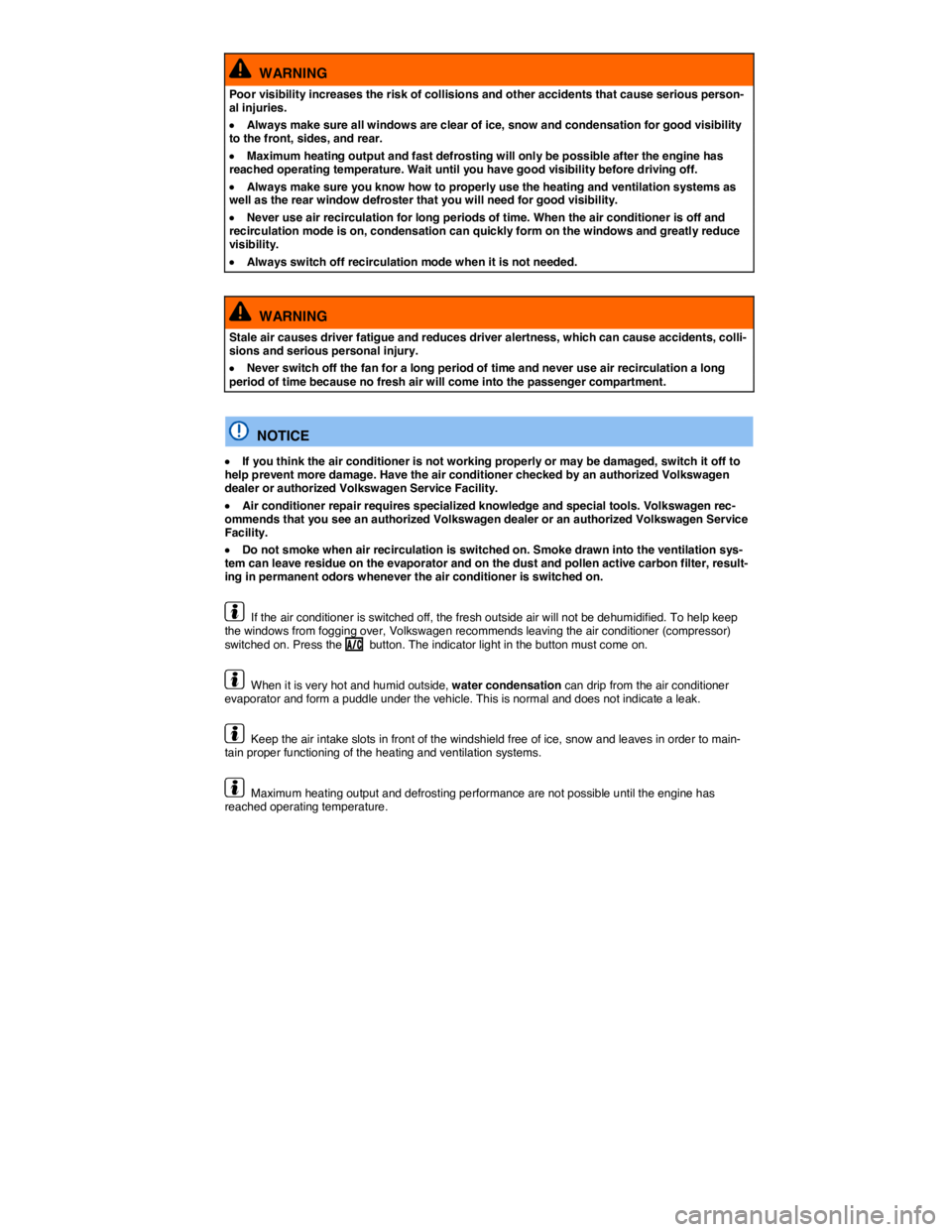2011 VOLKSWAGEN TOUAREG engine
[x] Cancel search: enginePage 440 of 684

Driving situa-
tions
Requirements and
conditions Vehicle behavior
– Avoid speeds of over
about 160 km/h
(99 mph).
Efficient sailing is possible with
a speed of about 160 km/h
(99 mph).
– Careful selection of
gear (S).
Sporty driving style with acti-
vated sport program increases
fuel consumption. Efficient
sailing in sport program with
combustion engine automati-
cally switched off is possible
with a speed of about 70 km/h
(43 mph).
Driving in cold
months.
– Do not warm up the
combustion engine by
running it with the vehi-
cle stationary.
The temperature of the com-
bustion engine increases very
slowly, but fuel consumption
increases considerably.
– Careful use of heating
for the rear window,
outside mirror, steering
wheel and front seats.
This prevents energy from
being lost and saves energy
for the electric motor.
– Leave the vehicle in a
garage overnight.
This prevents the high-voltage
battery and the vehicle interior
from cooling down too much.
The optimal temperature of the
high-voltage battery is reached
quicker at the beginning of the
journey and the combustion
engine can be switched off
quicker when the vehicle inte-
rior is sufficiently heated.
Page 442 of 684

switched of in this mode. Gentle start-ups (getting the vehicle going) and parking are also phases the electrical motor can often handle alone.
The combustion engine is started if you accelerate faster or if the charge level of the high-voltage battery gets too low. As soon as allowed by your acceleration and the high-voltage battery charge level, the vehicle switches back to electrical motor drive.
Use the following indicators to tell when the vehicle is being powered electrically:
�x Tachometer for the combustion engine shows zero engine revolutions.
�x Instrument cluster display.
�x Infotainment System screen.
Extended electro-mode drive (�%�
Page 443 of 684

This depends on vehicle conditions of the hybrid drive system is normal and is designed to save fuel. The power steering and the braking assistance systems remain active. In certain situations it may be necessary for the system to start the combustion engine even when the vehicle is not moving. With prolonged driving in traffic jams, the combustion engine will be switched on and off to charge the high-voltage battery for the following start-stop phase.
Sailing
If the accelerator is not depressed and the lever is in Drive (D), the internal combustion engine is switched off even at higher speeds. The vehicle then decelerates slower than conventional vehicles.
This feature can be used to help reduce fuel consumption when you keep traffic conditions in mind and can anticipate the vehicles power requirements. Even in this case, the rev counter in the instru-ment cluster displays zero engine speed (0 engine revolutions). The instrument cluster powermeter shows zero.
Brake energy regeneration (Recuperation/charge)
When the vehicle brakes, the electrical energy is generated by the electric motor, which works as an alternator and charges the high-voltage battery. The same thing occurs while the vehicle is coasting to a stop or driving downhill.
Energy regeneration is shown in the instrument cluster display or on the Infotainment System screen. The combustion engine may be switched off automatically in this situation. The instrument cluster powermeter registers below zero.
When the high voltage battery is fully charged, there is no brake energy recuperation, and therefore no engine braking. Recuperation and engine braking are also automatically reduced if the vehicle detects that the road conditions do not permit sufficient contact between the wheels and the road surface.
Automatic starting - combustion engine
The combustion engine is started automatically in a number of situations.
�x Engine temperature is too low.
�x Catalytic converter temperature is too low.
�x High-voltage battery being charged at high rate when decelerating. The high-voltage battery can-not absorb any more energy and for this reason the electric motor cannot brake the vehicle. The combustion engine comes on to help slow the vehicle down (engine brake).
�x Engine hood is open.
�x Leaving the vehicle when the electric motor is still “live”. The status of the electric motor is not always obvious, particularly when the combustion engine is not running. The combustion engine will therefore start if the driver's safety belt is unlatched or the driver's door is opened when the transmis-
sion is in Park (P) or Neutral (N) ⇒ Warning when leaving the vehicle.
Page 446 of 684

Maintenance of the high-voltage battery
Other than taking the vehicle in for scheduled maintenance to an authorized Volkswagen dealer or an authorized Volkswagen Service Facility that is qualified to do work on hybrid vehicles, there is nothing that the vehicle driver has to do to maintain the high-voltage battery.
The maintenance connection for the high-voltage battery is under the luggage compartment floor under an orange cover. This connection is only for scheduled maintenance, which must be performed only by specially trained service technicians. There is no need to remove the connector at any time
when the vehicle is being used ⇒
WARNING
The high-voltage hybrid electrical system is dangerous and can cause burns, other serious personal injuries, electrocution and death.
�x Never open, service, repair, or disconnect the high-voltage hybrid battery.
�x Never touch or let jewelry or other metal objects contact high-voltage cables or the high-voltage battery and battery poles, especially if the cables, battery, or battery poles have been damaged in a crash or in some other way.
�x Always have work on the hybrid electrical system and on systems that could be indirectly affected by it done by qualified, trained technicians, who have the know-how, experience, documentation, and tools to do the work safely.
WARNING
Failure to heed warning lights and instrument cluster text messages can cause the vehicle to break down in traffic and result in a collision and serious personal injury.
�x Never ignore warning lights or text WARNINGS.
�x Always stop the vehicle as soon as it is safe to do so.
NOTICE
�x Failure to heed warning lights or text WARNINGS can result in vehicle damage.
�x If the 12 Volt vehicle battery is disconnected or dead or has been replaced, there is a possi-bility that the combustion engine will not automatically switch off when the vehicle is powered by the electric motor. If this situation persists for several days, take the vehicle to an author-ized Volkswagen dealer or an authorized Volkswagen Service Facility that is qualified to do work on hybrid vehicles.
�x Never transport water or other liquids or fluids in open containers, such as an aquarium. If liquid is spilled in the luggage compartment, this can cause short circuits or damage the high-voltage battery.
NOTICE
Never block or cover the cooling air vents for the high-voltage hybrid battery under the rear seat. Blocking or covering these vents can damage the high-voltage battery.
Page 449 of 684

any requirement for engaging Hill Hold is no longer met while the vehicle is stopped, Hill Hold disen-gages, the indicator light in the button goes out, and the brakes are automatically released and will no longer hold the vehicle.
Hill Hold is activated automatically when points 1 to 3 are met at the
same time:
1. Hold the stopped vehicle on an incline with the foot brake or elec-
tronic parking brake.
2. The engine is running “smoothly”.
3. The transmission must be in Drive (D) or Sport Drive (S) and the
foot brake must be depressed to keep the vehicle from moving.
4. To drive off, take your foot off the brake pedal and gently depress
the accelerator within 2 seconds.
Release the brake as you gently depress the accelerator.
Hill Hold is immediately deactivated:
�x If any requirement listed in the table above is no longer met (see ⇒ table on page 453).
�x If the engine is not running smoothly or the engine malfunctions.
�x If the engine stalls or is switched off.
�x If the transmission is in Neutral (N).
�x If a tire does not have enough road contact (such as when the vehicle is tipped or at an angle).
WARNING
The intelligent technology of Hill Hold cannot overcome the laws of physics. Never let the increased convenience provided by Hill Hold tempt you into taking risks.
�x The Hill Hold feature cannot hold the vehicle in all hill start situations (for example, if the surface is icy or slippery).
�x Hill Hold can only help keep the vehicle from moving for less than 2 seconds. After that, the brakes will be released and the vehicle can roll down the hill.
Hill Descent Assist
�
Page 450 of 684

An indicator light �k comes on in the instrument cluster display whenever Hill Descent Assist is ena-bled. The indicator light blinks when Hill Descent Assist is regulating the brakes.
Hill Descent Assist is always enabled, but only regulates the brakes when certain requirements are met.
Hill Descent Assist regulates automatically:
�x If the vehicle is in off-road mode and the indicator light �k is on.
�x And: If your speed is under 18 mph (30 km/h).
�x And: If the downhill grade is 10 % or steeper.
�x And: If you neither accelerate nor apply the brakes.
�x And: If the vehicle's engine is running.
If you accelerate or step on the brake when Hill Descent Assist is operating, the feature switches off. Hill Descent Assist begins regulating speed again the next time the requirements are met.
Hill Descent Assist does not regulate speed:
�x On downhill grades of less than 10 %.
�x OR: At speeds over 18 mph (30 km/h).
�x OR: If the driver brakes or accelerates.
WARNING
Always be ready to apply the brakes. Otherwise accidents and injuries can occur.
�x Hill Descent Assist is merely a driving aid and cannot always slow the vehicle down enough under on downhill grades.
�x The vehicle may pick up speed despite the use of Hill Descent Assist.
The Hill Descent Assist also works when you are backing down a hill.
Page 475 of 684

Text message Meaning
ACC: Not
available.
Please manual-
ly accelerate
and brake.
ACC is not available. Driver intervention is neces-
sary.
Door open. ACC cannot be activated. Please close all doors and
engine hood.
Object ahead. A stationary object is detected ahead when ACC is
switched on and your vehicle is moving. ACC cannot
be activated.
Front Assist
deactivated.
Front Assist is deactivated.
WARNING
The view of the radar sensor can be impaired by rain, snow or heavy spray. Under certain circumstances, this could result in the vehicle ahead being detected inadequately or not at all. Take over yourself if necessary!
�x Switch Adaptive Cruise Control off when driving through tunnels because the function of the system could be impaired.
�x
�x Adaptive Cruise Control distance regulation will not work if the sensors are covered by heavy rain, spray, snow, etc. ACC not available. No sensor view! appears in the in-strument cluster display.
�x Adaptive Cruise Control switches off temporarily if the brakes overheat too much. ACC not available appears in the instrument cluster display.
Page 514 of 684

WARNING
Poor visibility increases the risk of collisions and other accidents that cause serious person-al injuries.
�x Always make sure all windows are clear of ice, snow and condensation for good visibility to the front, sides, and rear.
�x Maximum heating output and fast defrosting will only be possible after the engine has reached operating temperature. Wait until you have good visibility before driving off.
�x Always make sure you know how to properly use the heating and ventilation systems as well as the rear window defroster that you will need for good visibility.
�x Never use air recirculation for long periods of time. When the air conditioner is off and recirculation mode is on, condensation can quickly form on the windows and greatly reduce visibility.
�x Always switch off recirculation mode when it is not needed.
WARNING
Stale air causes driver fatigue and reduces driver alertness, which can cause accidents, colli-sions and serious personal injury.
�x Never switch off the fan for a long period of time and never use air recirculation a long period of time because no fresh air will come into the passenger compartment.
NOTICE
�x If you think the air conditioner is not working properly or may be damaged, switch it off to help prevent more damage. Have the air conditioner checked by an authorized Volkswagen dealer or authorized Volkswagen Service Facility.
�x Air conditioner repair requires specialized knowledge and special tools. Volkswagen rec-ommends that you see an authorized Volkswagen dealer or an authorized Volkswagen Service Facility.
�x Do not smoke when air recirculation is switched on. Smoke drawn into the ventilation sys-tem can leave residue on the evaporator and on the dust and pollen active carbon filter, result-ing in permanent odors whenever the air conditioner is switched on.
If the air conditioner is switched off, the fresh outside air will not be dehumidified. To help keep the windows from fogging over, Volkswagen recommends leaving the air conditioner (compressor) switched on. Press the �!�